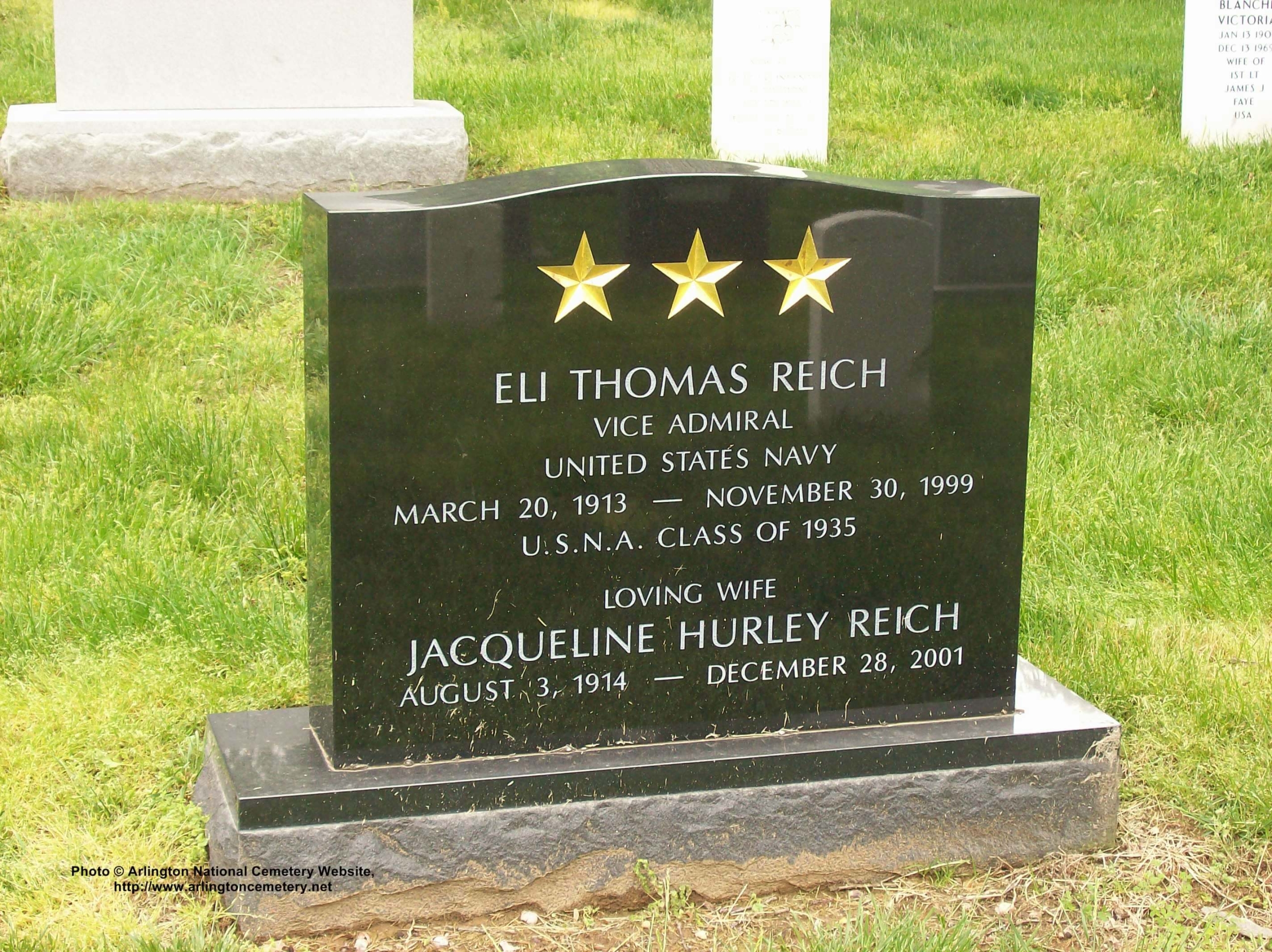From a contemporary press report:
Eli T. Reich, 86, a retired Navy Vice Admiral and decorated World War II submarine commander whose last assignment was Deputy Assistant Secretary of Defense for Logistics, died November 30, 1999 at the Jefferson health-care facility in Arlington. He had Alzheimer’s disease.
Admiral Reich received three awards of the Navy Cross, the highest military decoration for valor after the Medal of Honor, for “extraordinary heroism” as commander of the submarine Sealion in combat operations from March to December 1944. During that time, the Sealion sank thousands of tons of Japanese shipping.
The boat was credited with sinking the Japanese battleship Kongo and a prisoner of war ship, Ryuku Maru, which was en route from Singapore to the Japanese home islands. After sinking the POW ship, the Sealion surfaced and rescued 54 Australian and English prisoners of war from the sea, which was coated with burning oil. The men were delivered to a safe port after a voyage of several days on the extremely crowded sub.
Retiring from the Navy in 1973 after 38 years of service, Admiral Reich was named director of the Emergency Energy Allocations Program, which was responsible for the distribution of scarce oil and gasoline during the Arab oil embargo. Described as a “crusty three-star admiral” by syndicated columnists Rowland Evans and Robert Novak, Admiral Reich was reported by the columnists to have told staff members: “I don’t give a damn for the public image. We’re not here to create an image. We’re to do a job–my way. And that’s the military way.”
But after a month on the job, Admiral Reich clashed with energy chief William Simon, and he left the newly formed Energy Administration. The admiral did consulting later on national security matters involving weapons systems acquisitions, shipbuilding and mobilization planning.
Admiral Reich, a 30-year resident of Washington and Arlington, was born in New York and graduated from the U.S. Naval Academy at Annapolis in 1935. He attended submarine school in New London, Connecticut, then in 1939 became executive officer and engineer of an earlier version of the submarine Sealion. It was undergoing repairs at the Cavite Navy Yard in the Philippines when it was struck by several aerial bombs in a Japanese attack on December 10, 1941. Because of serious damage, the submarine was scuttled by its crew when Cavite was evacuated in late December of that year.
Admiral Reich served on the staff of the submarine commander at Corregidor and Bataan in the Philippines, escaping aboard another submarine before the surrender of U.S. forces there in the spring of 1942. He was executive officer aboard the submarine Lapon in 1943, then in March 1944 assumed command of the second submarine Sealion.
Actions over the next 10 months of operations in three war patrols would bring him a Navy Cross, a Gold Star in lieu of a second Navy Cross and another Gold Star in lieu of a third Navy Cross.
According to the citations accompanying the awards, he “penetrated strong enemy escort screens, and by a series of eight aggressive and well executed torpedo attacks succeeded in sinking four enemy ships, totaling19,600 tons. In addition, a well conducted gun attack resulted in the destruction of a 100 ton enemy sampan.” He “skillfully launched smashing torpedo attacks which resulted in the sinking of a 2,300 ton enemy destroyer, two large tankers and three large transports, for a total of 51,700 tons.” “Successfully penetrating strong enemy escort screens guarding an enemy task force of two battleships and two cruisers, Commander Reich launched two surface torpedo attacks, obtaining three hits on one of the battleships and one hit on the other, resulting in the sinking of the most severely damaged ship.”
Later in the war, Admiral Reich served on the staff of the submarine commander of the Pacific Fleet. Postwar assignments included duty in the office of the chief of naval operations and study at the Armed Forces Staff College and the Industrial College of the Armed Forces.
He was assistant chief of the Bureau of Naval Weapons, director of surface missile systems and commander of the anti-submarine warfare group in Southeast Asia during the early years of the war in Vietnam.
Other decorations included the Distinguished Service Medal with a Gold Star, the Legion of Merit and the Bronze Star.
He was a member of Catholic Church of the Annunciation in Washington.
Survivors include his wife of 57 years, Jacqueline Reich of Arlington; five children, Anne Reich of Falls Church, Thomas Reich of Silver Spring, Margaret Elevich of Absecon, N.J., Jacqueline Paolantonio of Wayne, Pa., and Mary Raneses of Vienna; 13 grandchildren; and one reat-grandchild.
REICH, ELI THOMAS, VADM USN (Ret.)
On Tuesday, November 30, 1999, Vice Admiral ELI THOMAS REICH, husband of Jacqueline Reich; father of Anne and Tom Reich, Meg Elevich, Jacque Paolantonio, Mary Raneses and the late George Reich. He is also survived by 13 grandchildren and one great grandchild. Friends may call at JOSEPH GAWLER’S SONS, 5130 Wisconsin Avenue, NW (at Harrison St.) on Thursday, December 16, 4 to 7 p.m. Mass of Christian Burial will be held at Fort Myer Chapel on Friday, December 17, at 12:45 p.m. Interment Arlington National Cemetery. In lieu of flowers, contributions may be made to the Naval Undersea Museum Foundation, 610 Dowell St., Keyport, VA 98345-7610.
Reich, Eli T, b. 03/20/1913, d. 11/30/1999, US Navy, VADM, Res: Falls
Church, VA, Section 30, Grave 950-A, buried 12/17/1999
Michael Robert Patterson was born in Arlington and is the son of a former officer of the US Army. So it was no wonder that sooner or later his interests drew him to American history and especially to American military history. Many of his articles can be found on renowned portals like the New York Times, Washingtonpost or Wikipedia.
Reviewed by: Michael Howard

